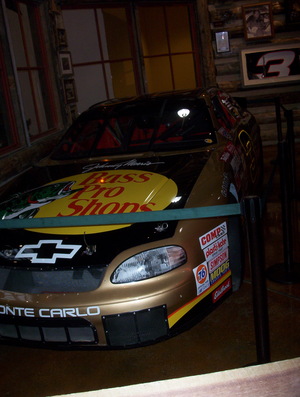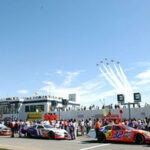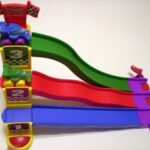Are you a new NASCAR fan? Or are you a lady forced to listen to it or watch it by your husband or boyfriend. Either way the language of racing can be confusing, here are some common terms that are used in NASCAR.
Banking- This has nothing to do with where they put all that cash they make. Banking refers to the slope of a racetrack. Degree of Banking means the height of a tracks slope on the outside edge of the track they are driving on
Downforce- Air Pressure pushing down on the car as it races. In corners downforce is needed to help the tires grip the track better. In a straightaway downforce is bad because it causes drag.
Drafting- Drafting is when two or more cars are in a straight line. The first car pulls the other cars along a bit in a vacuum. This slows the first car and any cars behind him are pulled along faster and use less fuel doing it.
Drag- This is the amount of wind resistance a car has while racing. The less drag, the faster the car, and the less fuel it uses.
Fabricator-No he isn’t a liar, a fabricator is the person who creates the sheet metal the car is made from.
Firewall- Solid metal plate separating the driver from the engine compartment. This protects the driver in case of accident.
Fuel Cell- This is the gas tank for the car. A metal box with a flexible tear-resistant bladder and foam padding to prevent fuel spilling.
Groove- Slang for the best way for a car to get around the track The high groove runs closer to the outside wall. The low groove runs closer to the apron at the inside or lower part of the track.
Handling – This is how the car handles or drives while going around the track.
Interval-The time or distance between two race cars. Given in car lengths or seconds.
Lapped Cars- Cars that have completed at least one full lap less than the leader.
Loose- Refers to a car that oversteers or when the back end of the car tries to overtake the front end of the car in a turn. A loose car is very dangerous.
Pit Road- The area of the track where pit teams service the cars. Mostly for tires and gas or minor adjustments.
Pole Position- The place where a car starts the race after qualifying. The faster the car qualifies the farther in front of other cars, he starts the race.
Push- refers to when the front tires do not turn sharply in turns. Thus it feels like the car is being pushed straight instead of turning.
Quarter Panel- Sheet Metal on the sides of the car Restrictor Plate- Aluminum Plate placed between the carburetor and the engine intake manifold. This decreases horsepower and speed. Used on the Super Speedways to slow them down to avoid high speed crashes.
Round- Slang for adjustments to the chassis with the cars springs by inserting a wrench into a jack bolt attached to the springs. This tightens or loosens the way the car handles.
Setup- The slang term for how the car’s suspension is set up before the race.
Short Track- Racetrack less than one mile in length.
Spoiler- Aka a Blade. Strip of aluminum across the the rear deck lid (the trunk on a real car) this causes downforce on the rear of the car, increasing traction. But it also causes drag.
Stick- Slang for tire traction
Stickers- New Tires
Stop N Go- When a driver is black flagged a stop n go penalty is enforced where the driver has to go to pit road and stop for at least one full second. Usually this is a punishment for speeding on pit road.
Super Speedway- A track more than one mile long
Sway Bar-Bar used to restrict the rolling force on a car in turns to keep it from flipping over
Tight- or under steer if the front wheels lose traction before the back ones do the car is tight.
Tri Oval- A track that has a 5th turn in addition to the normal 4 corners.
Turbulence- Force of air behind the race car.
Victory Lane- aka winners circle. Spot on the infield where the winning driver goes to celebrate after the win
Wedge- Refers to the corner to corner weight of the car. Adjusting wedge can make a car tighter or looser
I hope these terms help you have a good day







